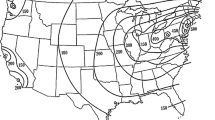Abstract
This paper examines demand for international telephone services. Using panel data covering 57 routes over 6 years, a model featuring a two-stage budgeting process and product differentiation is implemented for empirical estimation. A range of economic, social, cultural and technological variables are included in the aggregate-level model to study overall demand. The unique and rich data offers an opportunity to examine the impact of new technology innovations such as Internet on traditional telephone services. The company-level model incorporates product differentiation and uses the Almost Ideal Demand System to simultaneously estimate demands for and competition between carriers.
Similar content being viewed by others
References
J. P. Acton I. Vogelsang (1992) ArticleTitle‘Telephone Demand over the Atlantic: Evidence from Country-pair Data’ The Journal of Industrial Economics 40 305–323
J. M. Alston K. A. Foster R. D. Gree (1994) ArticleTitle‘Estimating Elasticities with the Linear Approximate Almost Ideal Demand System: Some Monte Carlo Results’ The Review of Economics and Statistics 76 351–356
T. W. Appelbe N. A. Snihur C. Dineen D. Farnes R. Giordano (1988) ArticleTitle‘Point-to-Point Modelling: An Application to Canada-Canada and Canada-United States Long Distance Calling’ Information Economics and Policy 3 311–331 Occurrence Handle10.1016/0167-6245(88)90030-3
F. Asche C. R. Wessells (1997) ArticleTitle‘On Price Indices in the Almost Ideal Demand System’ American Journal of Agricultural Economics 79 1182–1185
Bali Online (2002) Distance Calculator, available at: http://www.indo.com/distance/ index.html.
A. P. Barten (1966) Theorie en Empirie van een Volledig Stelsel van Vraagvergelijkingen, Ph.D. Dissertation, University of Rotterdam Rotterdam
E. R. Berndt D. O. Wood (1975) ArticleTitle‘Technology, Prices, and the Derived Demand for Energy’ The Review of Economics and Statistics 57 259–268
L. R. Christensen D. W. Jorgenson L. J. Lau (1975) ArticleTitle‘Transcendental Logarithmic Utility Functions’ American Economic Review 65 367–383
D. Cracknell (1999) ‘The Changing Market for Inland and International Calls’ D. G. Loomis L. D. Taylor (Eds) The Future of the Telecommunications Industry: Forecasting and Demand Analysis. Kluwer Academic Boston 61–81
J. Cui (2003) The Impact of Regulatory Policies and Technology Innovations on U.S. International Message Telephone Service Market, Ph. D. Dissertation, Temple University Philadelphia
A. Deaton J. Muellbauer (1980a) ArticleTitle‘An Almost Ideal Demand System’ The American Economic Review 70 312–326
A. Deaton J. Muellbauer (1980b) Economics and Consumer Behavior Cambridge University Press Cambridge
C. Dineen M. Abrar (1999) ‘Demand Modeling at Bell Canada: a Retrospective’ D.G. Loomis L.D Taylor (Eds) The Future of the Telecommunications Industry: Forecasting and Demand Analysis. Kluwer Academic Boston 80–101
A.K. Dixit J.E. Stiglitz (1977) ArticleTitle‘Monopolistic Competition and Optimum Product Diversity’ American Economic Review 67 297–308
T. Garin-Munoz T. Perez-Amaral (1998) ArticleTitle‘Econometric Modelling of Spanish Very Long Distance International Calling’ Information Economics and Policy 10 237–252 Occurrence Handle10.1016/S0167-6245(97)00032-2
P. Hackl A. H. Westlund (1996) ArticleTitle‘Demand for International Telecommunication: Time-Varying Price Elasticity’ Journal of Econometrics 70 243–260 Occurrence Handle10.1016/0304-4076(94)01691-7
H. Hotelling (1929) ArticleTitle‘Stability in Competition’ Economic Journal 39 41–57
International Monetary Fund (1994) Direction of Trade Statistics Yearbook, Washington, D.C
International Monetary Fund (2000) Direction of Trade Statistics Yearbook, Washington, D.C.
International Telecommunication Union (2002) World Telecommunication Indicators, Geneva.
D. W. Jorgenson L. J. Lau (1975) ArticleTitle‘The Structure of Consumer Preferences’ Annals of Economic and Social Measurement 4 49–101
J. A. Karikari K. Gyimah-Brempong (1999) ArticleTitle‘Demand for International Telephone Services between US and Africa’ Information Economics and Policy 11 407–435 Occurrence Handle10.1016/S0167-6245(99)00019-0
A. M. Lago (1970) ArticleTitle‘Demand Forecasting Models of International Telecommunications and Their Policy Implications’ Journal of Industrial Economics 19 6–21
K. Lancaster (1971) Consumer Demand; a New Approach Columbia University Press New York
A. C. Larson D. E. Lehman D. L. Weisman (1990) ‘A General Theory of Point-to-Point Long-Distance Demand’ A. Fontenay Particlede M. H. Shugard D. S. Sibley (Eds) Telecommunications Demand Modeling. North-Holland Publishing Co. Amsterdam 299–318
G. Madden S. J. Savage (2000) ArticleTitle‘Market Structure, Competition, and Pricing in United States International Telephone Service Markets’ The Review of Economics and Statistics 82 291–296 Occurrence Handle10.1162/003465300558803
G. Moschini (1995) ArticleTitle‘Units of Measurement and the Stone Index in Demand System Estimation’ American Journal of Agricultural Economics 77 63–68
M. Spence (1976) ArticleTitle‘Product Selection, Fixed Costs, and Monopolistic Competition’ Review of Economic Studies 43 217–235
R. Stone (1954) ArticleTitle‘Linear Expenditure Systems and Demand Analysis: An Application to the Pattern of British Demand’ The Economic Journal 64 511–527
L. D. Taylor (1980) Telecommunications Demand: a Survey and Critique Ballinger Pub. Co Cambridge
L. D. Taylor (1994) Telecommunications Demand in Theory and Practice Kluwer Academic Publishers Boston
H. Theil (1965) ArticleTitle‘The Information Approach to Demand Analysis’ Econometrica 6 375–380
U.S. Census Bureau (1997) Current Population Survey, March 1997, Washington, D.C
U.S. Central Intelligence Agency (2002) The World Factbook, Washington, D.C
U.S. Federal Communications Commission (1996). Common Carriers Scorecard , Washington, D.C
U.S. Federal Communications Commission (1998) Universal Service Monitoring Report, Washington, D.C
U.S. Federal Communications Commission (2001) Trends in the International Telecommunications Industry, Washington, D.C
Vives, X. (1999) Oligopoly Pricing: Old Ideas and New Tools. The MIT Press
World Tourism Organization (1998) Yearbook of Tourism Statistics, Madrid
World Tourism Organization (2001) Yearbook of Tourism Statistics, Madrid
Author information
Authors and Affiliations
Corresponding author
Rights and permissions
About this article
Cite this article
Cui, J. The Demand for International Message Telephone Services: A Two-Stage Budgeting Model. Rev Ind Organ 27, 167–183 (2005). https://doi.org/10.1007/s11151-005-1752-8
Issue Date:
DOI: https://doi.org/10.1007/s11151-005-1752-8




